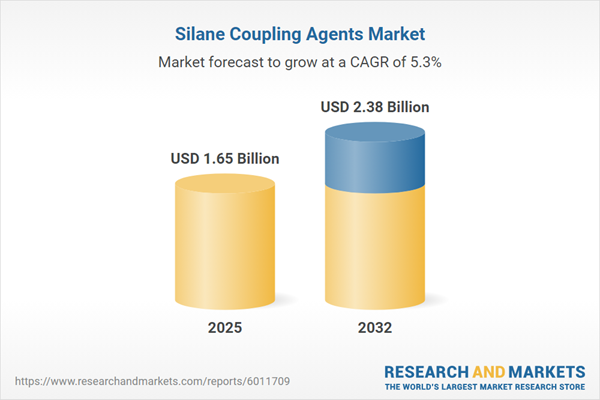Speak directly to the analyst to clarify any post sales queries you may have.
The Silane Coupling Agents Market is experiencing a period of dynamic transformation, driven by technological innovation, increasing sustainability priorities, and evolving regulatory landscapes. Strategic decisions are more critical than ever as leaders seek growth and resilience in this complex market environment.
Market Snapshot: Silane Coupling Agents Market Size and Growth
The silane coupling agents market grew from USD 1.57 billion in 2024 to USD 1.65 billion in 2025. It is projected to expand at a CAGR of 5.32%, reaching USD 2.38 billion by 2032. This growth reflects robust adoption across coatings, composites, and electronic applications amid tightening global quality standards and a continuous shift towards advanced material innovations.
Scope & Segmentation of the Silane Coupling Agents Market
This report provides a detailed analysis spanning product categories, regions, technologies, and leading companies.
- Product Types: Amino, Epoxy, Glycidoxy, Mercapto, Methacryloxy, Phenyl, Vinyl – each offering unique compatibility and performance benefits for industrial applications.
- Form: Liquid and Powder – enabling flexibility in processing, storage, and integration into manufacturing workflows.
- Applications: Coatings & Adhesives, Composite Materials, Fiber Treatment, Glass Ceramics, Rubber Plastics – addressing diverse performance and durability needs.
- End-Use Industries: Automotive & Transportation, Building & Construction, Electrical & Electronics, Energy & Chemical, Healthcare – industries where advanced adhesion, longevity, and regulatory compliance are paramount.
- Regions: Americas (including North America and Latin America), Europe, Middle East, and Africa, Asia-Pacific – markets exhibiting distinct regulatory, technological, and growth dynamics.
- Company Coverage: 3M Company, Advanced Polymer Inc, Anhui Sinograce Chemical Co., Ltd, Arkema S.A., Clariant AG, Dow Inc., Evonik Industries AG, Gelest, Inc., Hexpol Compounding HQ SA, Hubei Jianghan New Materials Co., Ltd., Jiangxi Chenguang New Materials Co., Ltd., JNC Corporation, KBG Corporation, KCC Corporation, Merck KGaA, Momentive Performance Materials Inc., Nippon Shokubai Co., Ltd., RAYTON CHEMICALS CO., LTD, Shin-Etsu Chemical Co., Ltd., Taizhou Huangyan Donghai Chemical Co.,Ltd., Tangshan Sunfar Silicon Industries Co., Ltd., Tianjin Shengbin Chemical Engineering, Wacker Chemie AG, WD Silicone Co., Ltd.
Key Takeaways for Senior Decision-Makers
- Silane coupling agents serve as molecular bridges, enhancing adhesion between inorganic and organic materials. This effect is crucial for durability, chemical resistance, and mechanical strength across sectors such as composites and high-tech encapsulants.
- Technological advances are producing functional silanes with superior thermal stability and tailored reactivity, allowing precise customization for end-use requirements and delivering targeted material innovation.
- Digitalization and predictive analytics empower producers to accelerate product development cycles, optimize formulation processes, and meet evolving customer and regulatory demands efficiently.
- Regional dynamics, including regulatory frameworks in EMEA, supply chain structures in Asia-Pacific, and industrial innovation in the Americas, play a central role in shaping adoption patterns and product preferences.
- Collaborations, innovation centers, and M&A activities among industry leaders enhance capability, global reach, and solution differentiation, supporting competitive and resilient value chains.
Tariff Impact: U.S. Tariffs and Supply Chain Adjustments
The introduction of revised U.S. tariffs in 2025 on precursor chemicals has prompted manufacturers to reconsider sourcing strategies and deepen supply chain resilience. Cost increases are driving shifts toward nearshoring, vertical integration, and renegotiation of supplier contracts. Decision-makers must prioritize proactive adaptation—such as diversifying sourcing and consolidating operations—to protect profitability and ensure continuity in an uncertain regulatory landscape.
Methodology & Data Sources
This report integrates secondary research from industry publications, regulatory documents, and technological databases with primary insights gathered through executive interviews, R&D specialists, and supply chain experts. Advanced data triangulation techniques were employed to validate findings, ensuring analytical integrity and actionable value.
Why This Report Matters for B2B Market Leaders
- Enables confident, well-informed strategy development by distilling complex market dynamics and technology advancements into clear, actionable insights.
- Supports faster, more targeted product innovation and sourcing decisions by providing comprehensive segmentation, emerging trends, and competitive benchmarking—all critical for staying ahead in the silane coupling agents space.
Conclusion
Leaders who adapt to technological, regulatory, and supply chain shifts will maximize success in the evolving silane coupling agents market. Informed strategy and agile execution are key to capturing growth and sustaining competitive advantage.
Additional Product Information:
- Purchase of this report includes 1 year online access with quarterly updates.
- This report can be updated on request. Please contact our Customer Experience team using the Ask a Question widget on our website.
Table of Contents
3. Executive Summary
4. Market Overview
7. Cumulative Impact of Artificial Intelligence 2025
Companies Mentioned
The companies profiled in this Silane Coupling Agents market report include:- 3M Company
- Advanced Polymer Inc
- Anhui Sinograce Chemical Co., Ltd
- Arkema S.A.
- Clariant AG
- Dow Inc.
- Evonik Industries AG
- Gelest, Inc.
- Hexpol Compounding HQ SA
- Hubei Jianghan New Materials Co., Ltd.
- Jiangxi Chenguang New Materials Co., Ltd.
- JNC Corporation
- KBG Corporation
- KCC Corporation
- Merck KGaA
- Momentive Performance Materials Inc.
- Nippon Shokubai Co., Ltd.
- RAYTON CHEMICALS CO., LTD
- Shin-Etsu Chemical Co., Ltd.
- Taizhou Huangyan Donghai Chemical Co.,Ltd.
- Tangshan Sunfar Silicon Industries Co., Ltd.
- Tianjin Shengbin Chemical Engineering
- Wacker Chemie AG
- WD Silicone Co., Ltd
Table Information
| Report Attribute | Details |
|---|---|
| No. of Pages | 186 |
| Published | November 2025 |
| Forecast Period | 2025 - 2032 |
| Estimated Market Value ( USD | $ 1.65 Billion |
| Forecasted Market Value ( USD | $ 2.38 Billion |
| Compound Annual Growth Rate | 5.3% |
| Regions Covered | Global |
| No. of Companies Mentioned | 25 |









